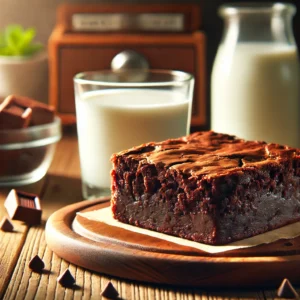
When you’re baking brownies, a simple substitution like using milk instead of water can dramatically change the outcome of your dessert. Many people wonder whether this switch can improve their brownies and how exactly milk affects the flavor, texture, and overall quality of the final product.
In this article, we’ll explore the impact of milk in brownies, the best types of milk to use, and some tips for achieving the perfect result. For more delicious brownie variations, check out this ultimate banana brownie recipe, which also showcases creative ways to elevate your brownies.
What Happens When You Add Milk Instead of Water?
The addition of milk changes both the flavor and texture of brownies in several ways. Compared to water, milk adds fats, proteins, and sugars that enrich the overall flavor and structure.
- Flavor: The fats in milk combine with chocolate to enhance the richness, while the proteins caramelize, giving the brownies a slight sweetness.
- Texture: Milk adds moisture and fat, resulting in brownies that are denser, fudgier, and creamier than those made with water.
How Milk Enhances the Flavor
The fat content in milk plays a crucial role in binding the flavors and making the brownies taste more indulgent. This is especially true if you’re using whole milk, which contains more fat than skim or non-dairy alternatives. If you’re looking for more information on the differences between brownie textures, this complete guide to brownie textures can help you understand how ingredients like milk impact the final product.
Types of Milk and Their Effects on Brownies
There are many types of milk you can use when substituting for water in brownie recipes, and each has a unique impact on the result:
- Whole Milk: Offers the richest, creamiest texture due to its higher fat content.
- Skim Milk: Lighter than whole milk, producing a slightly less fudgy result.
- Almond Milk: Dairy-free option with a mild nutty flavor that complements chocolate well.
- Coconut Milk: Adds extra moisture and a hint of tropical flavor, ideal for a unique twist.
- Oat Milk: Subtle sweetness with a creamy consistency, another good dairy-free option.
Adjusting Ingredients When Using Milk
When swapping milk for water in your brownie mix, it’s important to adjust other ingredients to maintain balance:
- Reduce sugar if you’re using sweetened milk like almond or flavored milk to avoid an overly sweet brownie.
- Increase fat slightly for non-fat or low-fat milk options such as skim or almond milk to maintain richness.
- Monitor bake time since brownies with milk may require a longer baking time due to the additional moisture.
For more tips on replacing common ingredients in brownies, explore whether you can replace butter with yogurt in brownies, which also covers substitution options that work well in baking.
Benefits and Drawbacks of Using Milk in Brownies
Benefits:
- Richer flavor: The fats in milk intensify the chocolatey flavor, making your brownies more decadent.
- Creamier texture: Using milk creates a fudgy, moist consistency that water-based brownies lack.
- Nutritional boost: Milk adds proteins, calcium, and other nutrients, making your brownies slightly more nutritious.
Drawbacks:
- Denser brownies: Some people prefer light, airy brownies, but using milk results in a denser, more fudge-like texture.
- Dietary limitations: If you’re lactose intolerant or following a vegan diet, dairy milk may not be an option. However, almond, oat, and other non-dairy milks work just as well.
FAQs About Adding Milk to Brownie Mix
Can I Use Almond Milk Instead of Water?
Yes, almond milk can be used as a substitute for water in brownies. It adds moisture and a subtle nutty flavor that enhances the overall taste.
Will Using Milk Make Brownies More Nutritious?
Yes, milk contributes extra protein, calcium, and fat, making your brownies slightly more nutritious than when using water.
Can I Mix Milk and Water?
Yes, mixing milk and water is a great way to balance richness and moisture in your brownies. This combination can yield a brownie that is both moist and light.
Conclusion
Using milk instead of water in your brownie mix is a simple way to add depth, flavor, and texture to your brownies. Whether you opt for dairy or non-dairy milk, this substitution creates a richer, fudgier dessert that will impress anyone who takes a bite. If you’re looking to experiment with more ingredient swaps or unique brownie recipes, check out this ultimate brownie cake recipe for more inspiration.
